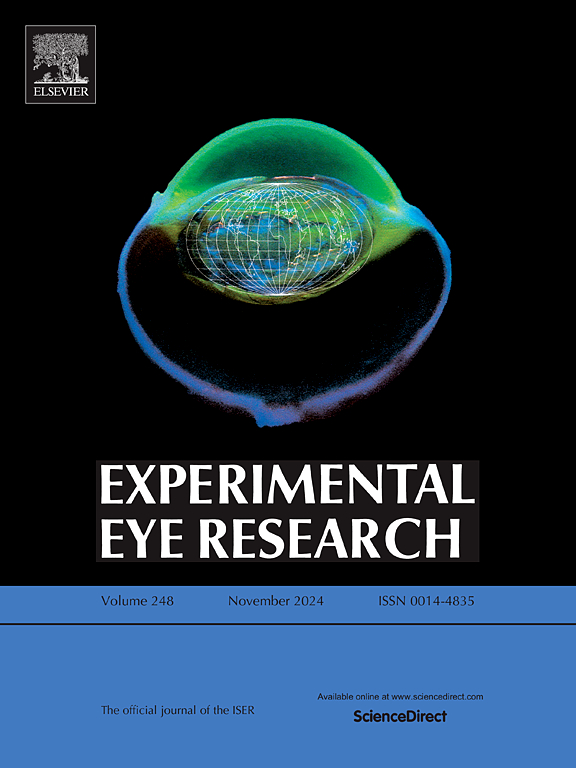IF 3
2区 医学
Q1 OPHTHALMOLOGY
引用次数: 0
摘要
眼表(OS)与其他粘膜部位一样,寄生着多种多样的微生物群。然而,人们对糖尿病引起的高血糖对眼表微生物组成的影响仍然知之甚少。在这项研究中,我们在 C57BL/6J 小鼠中建立了 1 型糖尿病(T1DM)和 2 型糖尿病(T2DM)模型,对 T1DM 小鼠施用高剂量链脲佐菌素(STZ),对 T2DM 小鼠施用低剂量 STZ 并结合高脂饮食。利用 16S rRNA 测序对 OS 微生物组进行了表征和分析。结果显示,与正常小鼠相比,T1DM 和 T2DM 都不会显著影响微生物的丰富度;但是,T2DM 导致微生物多样性显著减少。T2DM 中微生物多样性的减少与已知的糖尿病微生物菌群失调一致,这可能是干眼症和糖尿病视网膜病变等眼部并发症的发病机制之一。群落组成分析表明,正常小鼠OS的核心细菌是蛋白杆菌、天竺葵杆菌和阿利霍埃弗拉菌。糖尿病明显改变了不同分类水平的OS微生物组成。具体来说,T1DM 与 9 个标志性细菌物种有关,包括海洋螺旋菌属、芽孢杆菌属、卤单胞菌属、未分类的拉赫诺斯皮拉菌科(f_Lachnospiraceae)和无氧芽孢杆菌属(Anoxybacillus)。T2DM 表现出 17 种细菌标记,包括固醇菌、葡萄球菌、棒状杆菌和副伞菌。利用 PICRUSt2 对微生物群进行的功能预测表明,糖尿病可能会影响碳水化合物的代谢。总之,糖尿病小鼠的OS微生物群表现出严重的失调,恢复糖尿病患者的微生物平衡可能是预防和治疗糖尿病OS病变的一种有前途的策略。本文章由计算机程序翻译,如有差异,请以英文原文为准。
Impact of streptozotocin-induced type 1 and type 2 diabetes on ocular surface microbial signatures in C57BL/6J mice
The ocular surface (OS), like other mucosal sites, hosts a diverse microbiome. However, the impact of hyperglycemia associated with diabetes on OS microbial composition remains poorly understood. In this study, we established type 1 diabetes mellitus (T1DM) and type 2 diabetes mellitus (T2DM) models in C57BL/6J mice by administering high-dose streptozotocin (STZ) for T1DM and low-dose STZ combined with a high-fat diet for T2DM. The OS microbiome was characterized and analyzed using 16S rRNA sequencing. The results showed that neither T1DM nor T2DM significantly affected microbial richness compared to normal mice; however, T2DM led to a significant reduction in microbial diversity. This reduction in microbial diversity in T2DM is consistent with known microbial dysbiosis in diabetes, which may contribute to the pathogenesis of ocular complications such as dry eye disease and diabetic retinopathy. Community composition analysis identified Proteobacteria, Pelagibacterium, and Aliihoeflea as the core OS bacteria in normal mice. Diabetes significantly altered the OS microbial composition at various taxonomic levels. Specifically, T1DM was associated with 9 signature bacterial species, including Oceanospirillales, Bacillales, Halomonas, unclassified_f_Lachnospiraceae, and Anoxybacillus. T2DM exhibited 17 bacterial markers, including Firmicutes, Staphylococcus, Corynebacterium, and Parasutterella. Functional prediction of the microbiota using PICRUSt2 indicated potential impairments in carbohydrate metabolism due to diabetes. In conclusion, diabetic mice exhibit severe dysregulation of their OS microbiota, and restoring microbial balance in diabetic patients may represent a promising strategy for preventing and treating diabetic OS pathologies.
求助全文
通过发布文献求助,成功后即可免费获取论文全文。
去求助
来源期刊

Experimental eye research
医学-眼科学
CiteScore
6.80
自引率
5.90%
发文量
323
审稿时长
66 days
期刊介绍:
The primary goal of Experimental Eye Research is to publish original research papers on all aspects of experimental biology of the eye and ocular tissues that seek to define the mechanisms of normal function and/or disease. Studies of ocular tissues that encompass the disciplines of cell biology, developmental biology, genetics, molecular biology, physiology, biochemistry, biophysics, immunology or microbiology are most welcomed. Manuscripts that are purely clinical or in a surgical area of ophthalmology are not appropriate for submission to Experimental Eye Research and if received will be returned without review.
 求助内容:
求助内容: 应助结果提醒方式:
应助结果提醒方式:


